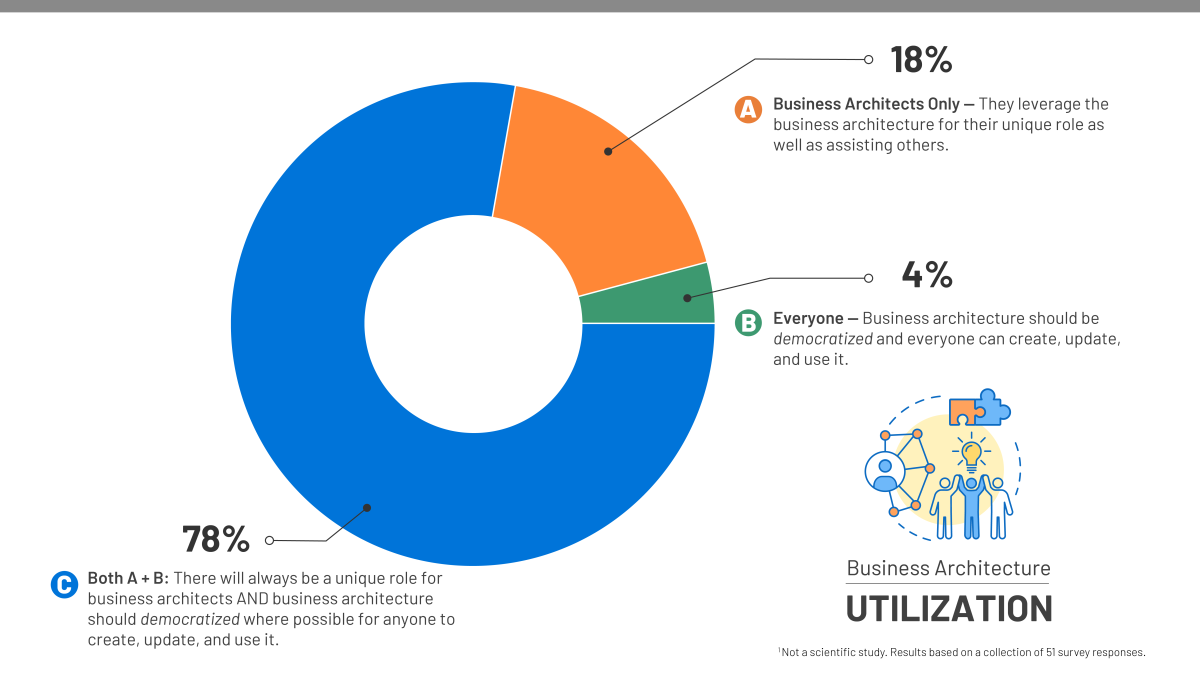The survey results show that the business architecture community strongly indicates (78%) that business architecture should be used by business architects and other people within an organization. This means that there will always be a unique role for business architects, but business architecture should also be democratized where possible for anyone to create, update content, and most certainly use it for value. This is likely one of the best ways for business architecture to become embedded, adopted, and used within an organization. As one participant stated, “For business architecture thinking to take hold, it needs to be seen as delivering value across all levels of the organization…”
A sample of the insightful comments shared by survey participants are below.
- "For Business Architecture "thinking" to take hold, IMO, it (Business Architecture) needs to be seen as delivering value across all levels of the organization. This "requirement" indicates that Business Architecture needs to be democratized across the organization with "specialist" that bring changes to the "framework" as improvements. Thus, change management, is the foundation anchor for Business Architecture."
- "Business Architecture can pull the purpose and strategy of an organization from top C-Suite leaders all the way through to each individual employee. When a merger/acquisition occurs, comparing architectures can expedite the transaction. When budget cuts are required or surplus available, decisions can be made with knowledge of how the work aligns to the org and strategy. Creating business architecture takes skill and training to do correctly; which is why response C is more accurate."
- "While I do think business architecture will need business architects for the foreseeable future, I sometimes wonder if it might be more effectively performed by strategists trained in bus arch methods... or product teams trained in bus arch methods. There would be down sides and challenges, but the dedicated bus arch role can also have downsides and challenges -- primarily the risk of being siloed or operating on the periphery of the partners with whom we need to co-create, support, and influence."
- "Business architecture should be embedded and available to the org units that it refers to as views that make sense to them, that they recognise as being what they do and how they are structured and so that they can use day to day. They should be in a position to inform business architects when they need to be updated."
- "Most stakeholders won’t have the training to interpret the results of business architecture efforts. So in most cases, business architects will need to apply the results of their efforts to specific processes. For example, if a capability heatmap is generated for the enterprise but the actual funding of change programs happens in silos, then the business architect may need to create a silo-specific view of the capability heatmap and then produce a nice excel sheet that lists the prioritized programs and why they should occur in this funding cycle."
- "Business architects should develop the business architecture to be consumed by investment decision makers, product management, other enterprise architects, and the development teams. If the organization is mature in portfolio management, this could also be a potential consumer."
- "Business Architecture is still new in many organisations, so Business Architects who understand the discipline should be the ones who should leverage the Business Architecture to translate strategy."
- "I'm going with option B due to the word "always" in option C. When aligning bus arch activities and work products with those of our partners (e.g., Strategy and Product Management), we first try to focus on the big, collective picture of WHAT needs to be done -- independent of WHO is going to do it. As we move from WHAT to HOW we're going to "do it", focus shifts to the collective set of methods, practices, artifacts, work products that will be needed -- and bus arch practices come into play the context of tools and techniques. Then comes the WHO -- and does it REALLY need to be performed by a dedicated business architect?"
- "Use and create is different - everyone should use it since the Business Architecture should represent the blueprint of the business, but not everyone can create the architecture - as everyone cannot create the blueprints when building a house. The Business Architects are equipped with specialised tools and techniques to capture the architecture and while some roles like the Business Analyst and Process Engineers contribute and expand the architecture "everyone" cannot just create/update it."
- "Business Architects own the creation of models and the activity of modeling the business, however, once created, can be standardized in their use to solve for. problems, opportunities, and/or initiatives. Once a process is created to identify Stakeholder outcomes and operational impacts, other Analysts in the organization can consume and use in practical situations. I found this to be one way to scale, and gain value from the modeling effort."
- "The purpose of any architecture should be transparency, which is best achieved through hands-on experience."
- "If I had three wishes, one of them would be that C would come true before I retire."
- "Love the idea of democratisation, but it sounds like a recipe for duplication, redundancy and chaos!"
